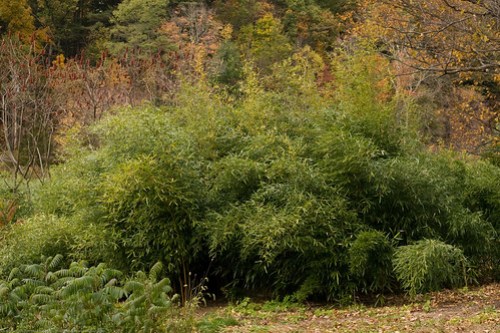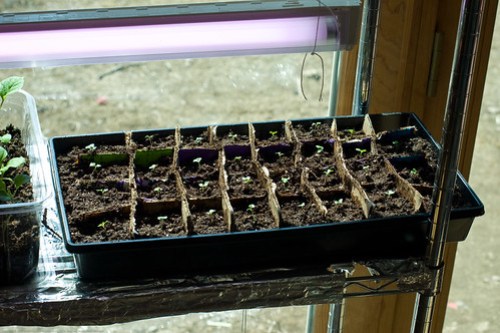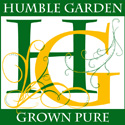 (Eric and Jonathan teaching on first day of workshop)
(Eric and Jonathan teaching on first day of workshop)
Recently I had the great fortune of attending Eric Toensmeier‘s Edible Forest Gardening workshop in Holyoke, MA Oct 16 to Oct 18. Before I go any further let me just say that if you have a chance, please go to this workshop the next time they hold it. You will be very glad you did! I am not sure when the next one might be. I will certainly blog about it here when I find out. There are other workshops that look VERY interesting at Eric’s “Event” page.
 (Eric standing under a paw paw tree, freezing with the rest of us!)
(Eric standing under a paw paw tree, freezing with the rest of us!)
As you may recall, Eric, along with Dave Jacke, wrote “Edible Forest Gardens (Vol.s 1 and 2)” and he also wrote “Perennial Vegetables“, a resource for those of you interested in learning about new perennial edibles suitable for your region.
There were three other people who made this event possible.
 (Jonathan sharing these really cute little cucumber like fruitlets)
(Jonathan sharing these really cute little cucumber like fruitlets)
Jonathan Bates, of Food Forest Farm, who was a fantastic co-presenter and amazing resource for so many of the MILLIONS of questions that I had. Check out his site and learn more about what his farm can do for your budding perennial food garden.
 (Steve answering our many questions while on a walk through some of his land)
(Steve answering our many questions while on a walk through some of his land)
Steve Breyer, Tree God Extraordinaire and moss evangelist of the Tripple Brook Farm, very generously hosted the workshop on two of the days. His farm / nursery is an amazing play land of edible plants and northern food bearing trees.
And finally, Marikler Toensmeier (Eric’s lovely wife) who did a ton of work putting together all the delicious and wholesome foods at this event. I dont have any photos of Marikler because it seemed intrusive!
The conference began on the evening of Friday October 16th at Holyoke Community College. We gathered in the conference room you see in the photo at the top of this page and Eric and Jonathan did a lovely job of immersing us into the world of edible forest gardening with an overview of the various aspects of forest and forest-like gardens as well as some permacultural principles.
This got us ready for the next day when we were going to be meeting at Eric and Jonathan’s homes and shared urban perennial garden for a tour and further discussions about edible forest garden design. If you have the book Perennial Vegetables, you will recognize his garden in some of the photos in the book.
Before we ended the night, we snacked on ripe paw paws!
 (Paw paws)
(Paw paws)
The next morning, Saturday, bright and early and quite chilly, we met at Eric and Jonathan’s home to begin our tour. We started with the very sunny morning sun side of the house and learned about it’s microclimate and the sorts of plants that they are able to grow there. Mind you, back in my garden it had been snowing and the season was DEFINITELY over. It actually snowed at our home while it was nice in Holyoke.
We started the day off by tasting these cute super tiny wild cucumber like fruitlets. I can not remember the name of this plant, sorry!
 (Jonathan with wild cucumber like plants)
(Jonathan with wild cucumber like plants)
They also grow non-edible bananas here.
 (Banana tree)
(Banana tree)
 (A hardy kale)
(A hardy kale)
 (Other hardy subtropicals)
(Other hardy subtropicals)
We walked into the back and learned about how they went from a hardpack urban waste lot to a wonderful abundant perennial garden via a specific design process.
 (Phil talking to Jonathan as he holds up plans that came out of their design process)
(Phil talking to Jonathan as he holds up plans that came out of their design process)
I want to take an aside and say just how glad I am to have gotten a chance to meet Phil and Tom, up from Brooklyn. They have been diligent campaigners for our world and transition. They have put together peak oil, permaculture, urban gardening, and many other sorts of events in the NYC area over the years. I look forward to getting to know them better in the future!
We then split up into groups and Eric and Jonathan took us through the garden, plant by plant, and explained pretty much everything about them from their polyculture setting, to their function in the larger design, to the types of fruits they bore (and we got many taste tests) as well as how they didnt fit in or might need to be or had been modified or moved to be a better part of the whole design.
Here are a few photos from the tour.
 (Eric pointing out paw paw fruits)
(Eric pointing out paw paw fruits)
 (Marikler and I made sea kale quiches – REALLY delicious)
(Marikler and I made sea kale quiches – REALLY delicious)
 (More Sea Kale)
(More Sea Kale)
 (Asparagus Berries)
(Asparagus Berries)
 (Jonathan holding forth over the comfreys)
(Jonathan holding forth over the comfreys)
 (Comfrey in question)
(Comfrey in question)
 (Comfrey close up)
(Comfrey close up)
 (Sweet cicely and a weed that I have LOTS of [purple in photo] turns out it was used by native americans in region)
(Sweet cicely and a weed that I have LOTS of [purple in photo] turns out it was used by native americans in region)
 (Comfrey and sweet cicely)
(Comfrey and sweet cicely)
 (Eric and others chatting by tool shed and chicken house)
(Eric and others chatting by tool shed and chicken house)
 (Lunch! I made homemade bread for the occasion)
(Lunch! I made homemade bread for the occasion)
After lunch we took off for the Tripple Brook Farm to begin a look at a large scale of edible forest gardening.
As I mentioned before, Steve Breyer owns this amazing place. There is so much one can say but I am going to simply share images from the tour we took.
 (Bamboo in the wild Massachusetts country side)
(Bamboo in the wild Massachusetts country side)
 (A neat tree with fruits but I do not know the name. They look like yellow cherries)
(A neat tree with fruits but I do not know the name. They look like yellow cherries)
 (American Persimmons)
(American Persimmons)
 (Honeysuckle pods, I think)
(Honeysuckle pods, I think)
 (Steve discussing tree husbandry and planting strategies)
(Steve discussing tree husbandry and planting strategies)
 (Chestnut husks are PAINFUL to the touch)
(Chestnut husks are PAINFUL to the touch)
Steve feels very strongly that mosses should be the preferred ground cover (versus grasses).
 (Ground covers)
(Ground covers)
 (Super tiny thyme ground cover)
(Super tiny thyme ground cover)
 (Black walnut tree with nuts in husks on tree)
(Black walnut tree with nuts in husks on tree)
 (Black walnut tree with nuts in husks on tree)
(Black walnut tree with nuts in husks on tree)
These photos totally do not give you a sense for how raw and cold it was that day. At this point in the tour we sheltered in Steve’s work shed (with warm wood stove) where we got to taste pine nuts, chestnuts and hardy kiwis and american persimmons and dogwood tree fruits (Cornus kousa).
 (Korean pine cones)
(Korean pine cones)
 (Korean pine nut husks)
(Korean pine nut husks)
 (Hardy kiwis, the taste was AMAZING)
(Hardy kiwis, the taste was AMAZING)
 (dogwood tree fruits (Cornus kousa))
(dogwood tree fruits (Cornus kousa))
 (dogwood tree fruits (Cornus kousa))
(dogwood tree fruits (Cornus kousa))
 (Black walnuts in their husks)
(Black walnuts in their husks)
 (American Persimmons – super delicious)
(American Persimmons – super delicious)
 (American Persimmons – super delicious)
(American Persimmons – super delicious)
Steve had the chestnuts roasting on the woodstove all morning. We have nut allergies so I didnt taste them but I fell in love with the way they looked! I shot a series of photos of these crazy spiky chestnuts.
 (Chestnuts in husks)
(Chestnuts in husks)
 (Chestnuts in husks)
(Chestnuts in husks)
 (Chestnuts in husks)
(Chestnuts in husks)
 (Chestnuts in husks)
(Chestnuts in husks)
 (Roasted chestnuts)
(Roasted chestnuts)
 (Opening roasted chestnuts)
(Opening roasted chestnuts)
 (Opening roasted chestnuts)
(Opening roasted chestnuts)
 (Paw paw)
(Paw paw)
 (Opened paw paw, hardy kiwis and dogwood tree fruits (Cornus kousa)
(Opened paw paw, hardy kiwis and dogwood tree fruits (Cornus kousa)
That evening we went back to Holyoke community college and delved deeper into polyculture design and learned quite a lot about grouping polycultural plantings that enhance and nurture each other and which build a more robust environment.
Some of what we learned that evening we used the next day in a practical way.
I went home just wiped out from that day. I was really worried that I would have no energy to get up and make the hour drive out early on Sunday, the third and last day. An odd thing happened though. I awoke really refreshed and ENJOYED driving at the crack of dawn out into the cold weather. I think there is something in these fruits that did me some good. Its also the fresh air and also, hugely more important, that I was doing something I found VERY exciting and engaging and with people who I really respected and admired.
This is quite a change from most of the jobs I have had in recent years – soul robbing activities. I can definitely see myself doing this for a living (I cant say how but it would be deeply satisfying).
The third day was intense. We assembled ourselves in Steve’s work shed and set to work on designing a new planting design for part of his nursery.
We did site assessment, analysis, and then in-depth design, as groups. It was an exercise in design as well as interpersonal communications.
While we didnt implement this particular design (there is only so much you can do in a few hours!) we pitched in and helped clean up the site and also put in some new plantings.
I have learned so much from this workshop. I would recommend it highly to anyone and I hope that some of you are able to attend future events like this. If you cant come out to tundra-like Massachusetts, you likely can find some near you!
Let me know if you do and how it goes!






























































































































